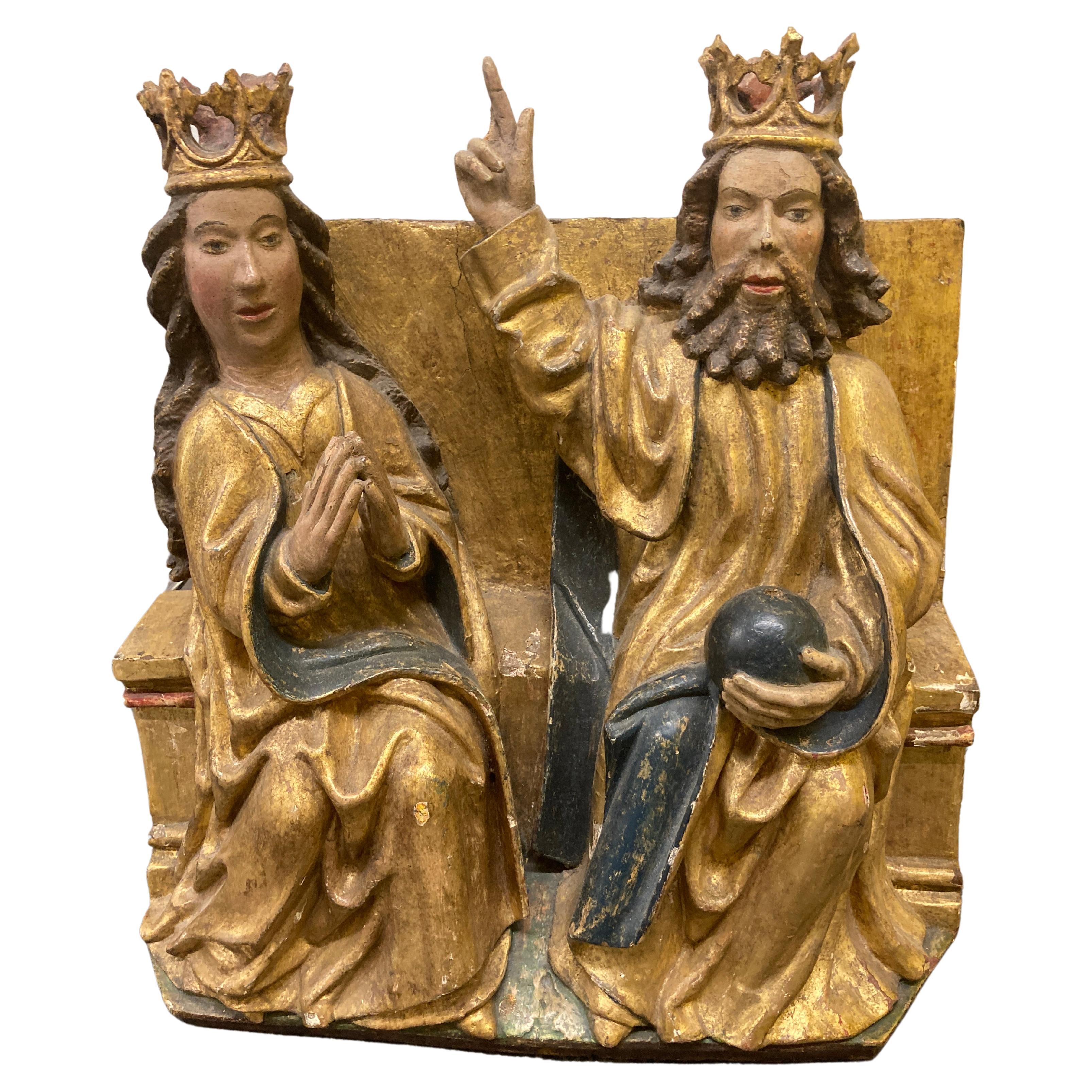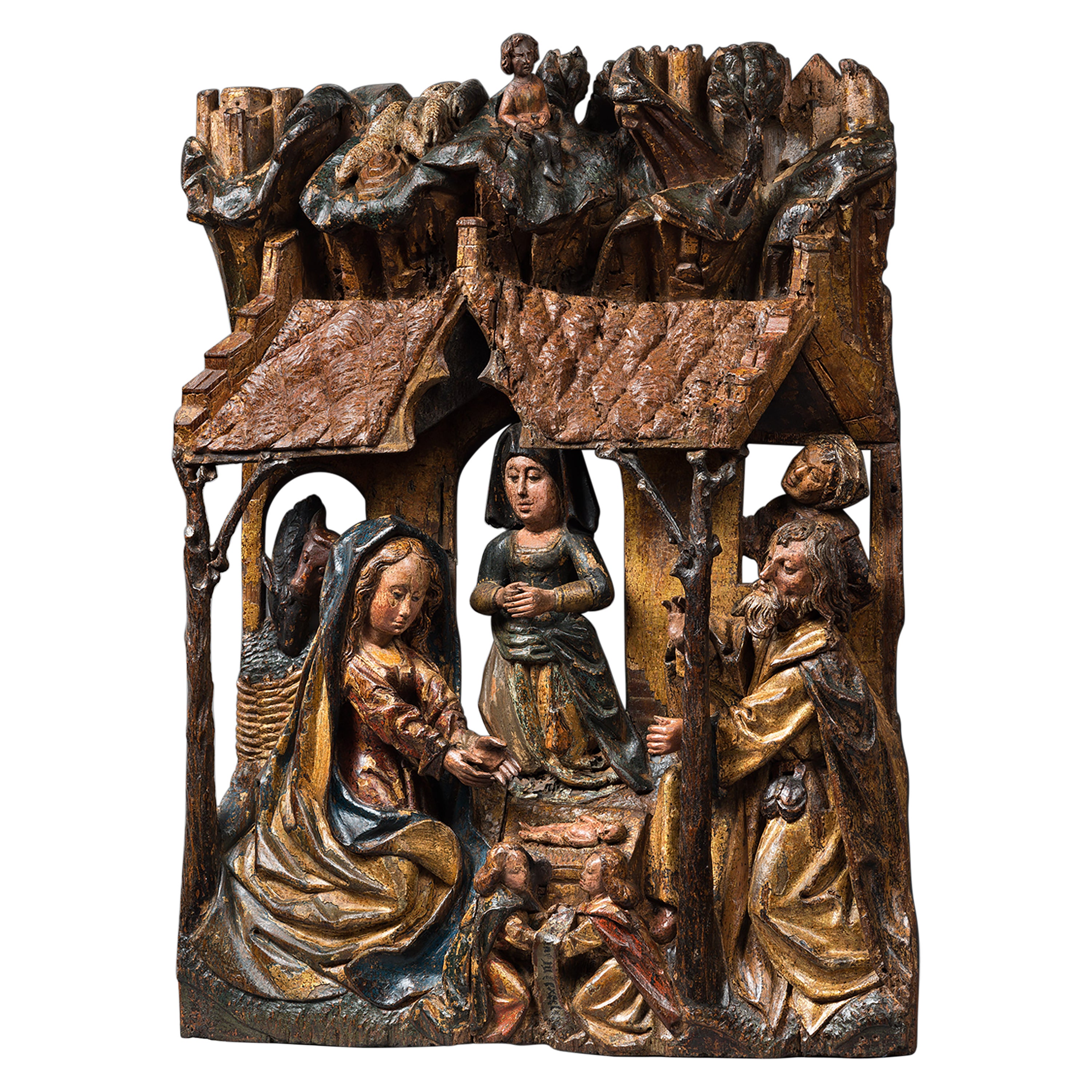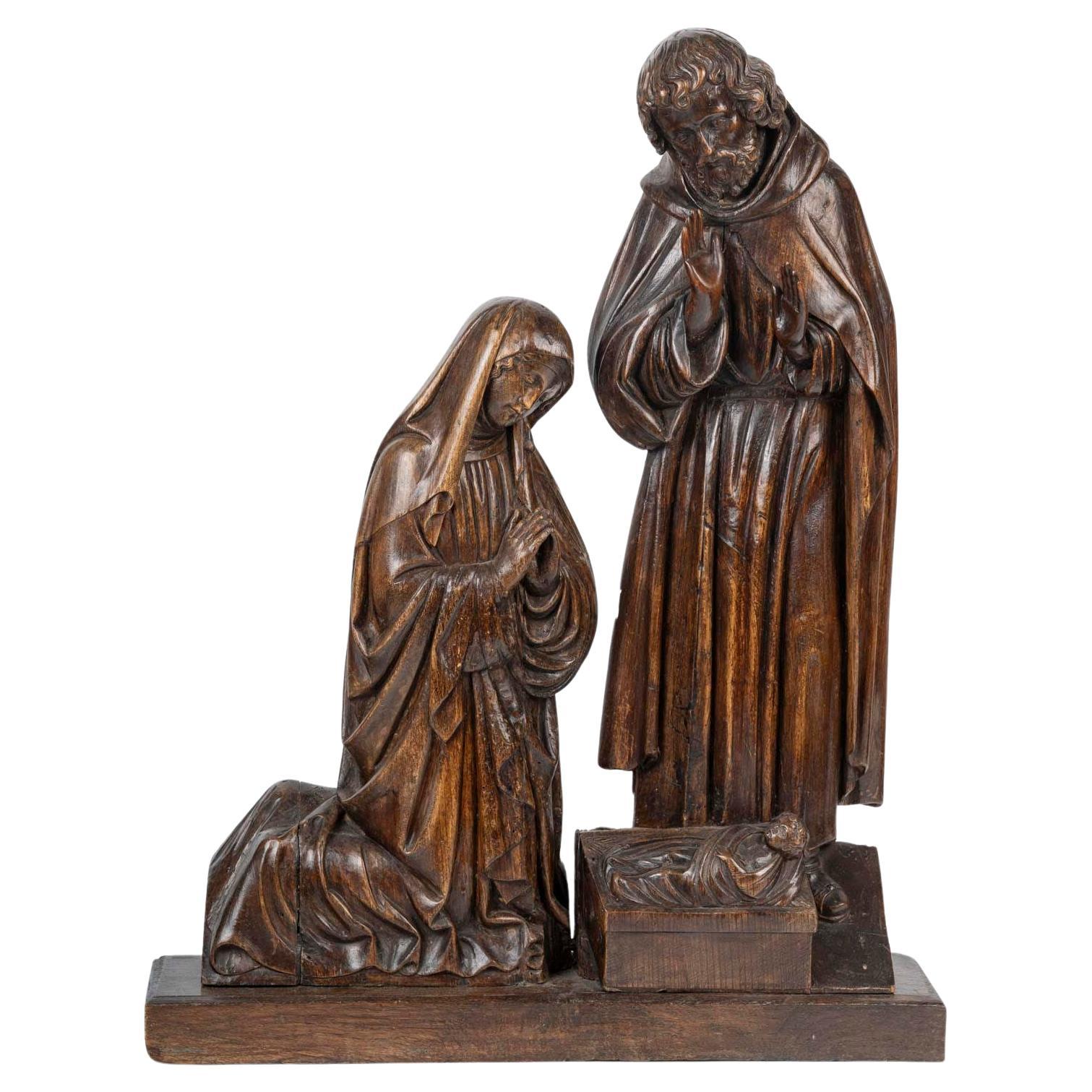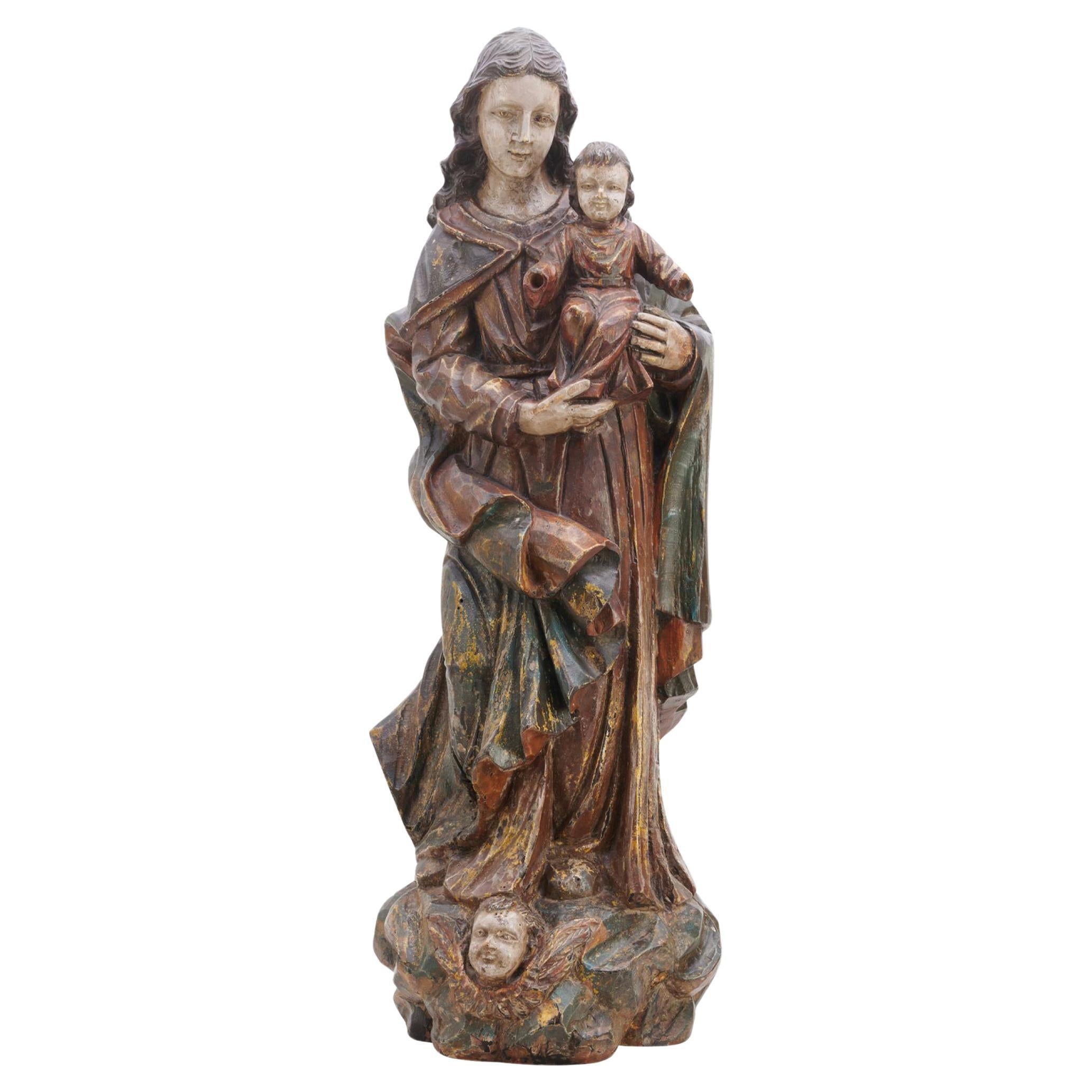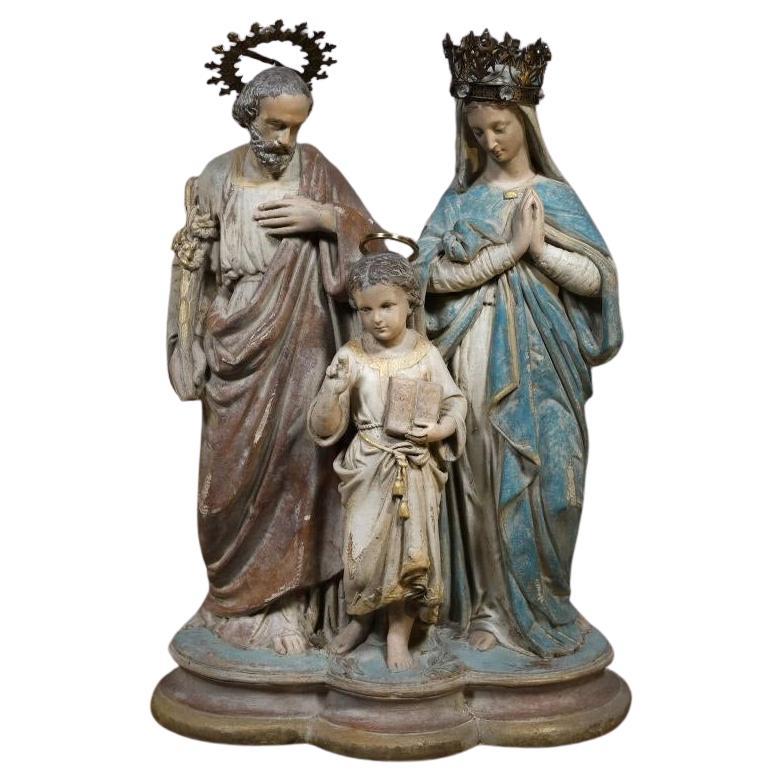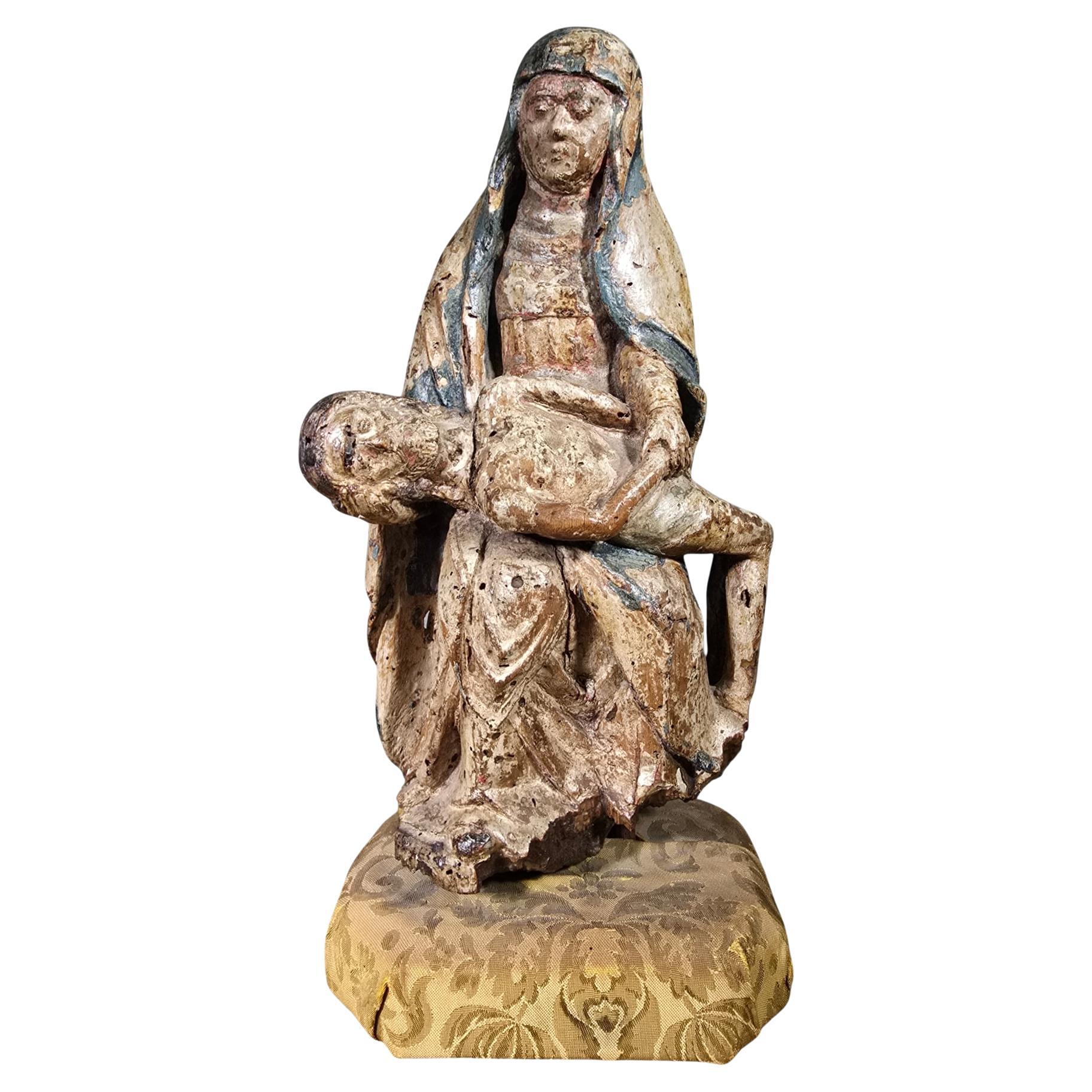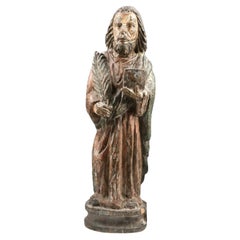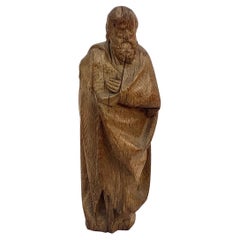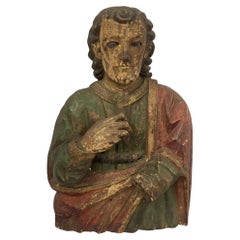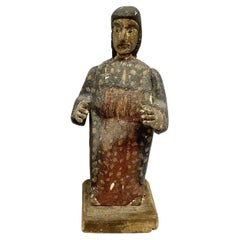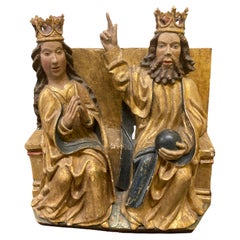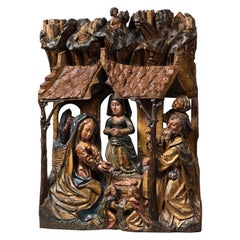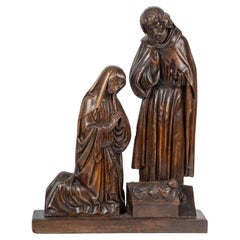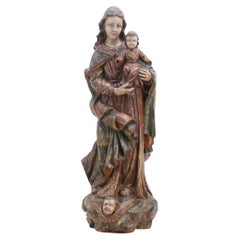Items Similar to Flemish Polychrome Sculpture of the Meeting of St. Joachim and St. Anna
Want more images or videos?
Request additional images or videos from the seller
1 of 7
Flemish Polychrome Sculpture of the Meeting of St. Joachim and St. Anna
$3,600
£2,728.59
€3,158.61
CA$5,082.26
A$5,659.51
CHF 2,954.96
MX$68,575.41
NOK 37,265.14
SEK 35,162.59
DKK 23,578.68
About the Item
Flemish Polychrome Sculpture of the Meeting of St. Joachim and St. Anna. Sandstone cast over limestone depicting St. Joachim and St. Anna's embrace at the Golden Gate after the news of the immaculate conception of The Virgin Mary, faint carved inscription on base states, "Joachim - Anna" circa 1500. St. Joachim and St. Anna are the parents of the Virgin Mary and are often depicted in medieval and Renaissance art, especially in devotional works meant to reflect piety and the holy family. Wonderful patina. Weighs approximately 90 pounds.
- Dimensions:Height: 31 in (78.74 cm)Width: 10 in (25.4 cm)Depth: 6 in (15.24 cm)
- Style:Gothic (In the Style Of)
- Materials and Techniques:
- Place of Origin:
- Period:
- Date of Manufacture:19th Century
- Condition:Wear consistent with age and use.
- Seller Location:Bradenton, FL
- Reference Number:Seller: 1931 X1stDibs: LU6067242283332
About the Seller
5.0
Platinum Seller
Premium sellers with a 4.7+ rating and 24-hour response times
Established in 1991
1stDibs seller since 2021
357 sales on 1stDibs
Typical response time: 2 hours
- ShippingRetrieving quote...Shipping from: Bradenton, FL
- Return Policy
Authenticity Guarantee
In the unlikely event there’s an issue with an item’s authenticity, contact us within 1 year for a full refund. DetailsMoney-Back Guarantee
If your item is not as described, is damaged in transit, or does not arrive, contact us within 7 days for a full refund. Details24-Hour Cancellation
You have a 24-hour grace period in which to reconsider your purchase, with no questions asked.Vetted Professional Sellers
Our world-class sellers must adhere to strict standards for service and quality, maintaining the integrity of our listings.Price-Match Guarantee
If you find that a seller listed the same item for a lower price elsewhere, we’ll match it.Trusted Global Delivery
Our best-in-class carrier network provides specialized shipping options worldwide, including custom delivery.More From This Seller
View AllEarly Carved Wood And Polychrome Religious Figure
Located in Bradenton, FL
Beautifully carved religious figure, of solid wood painted in colors of red, brown and green. Figure is bearded and holding a book in left hand and a large feather in right hand, res...
Category
Antique 19th Century Spanish Spanish Colonial Figurative Sculptures
Materials
Wood
17th Century German Carved Oak Religious Sculpture
Located in Bradenton, FL
17th Century German hand-carved oak religious sculpture. Possibly a saint or a bishop. The bearded man is cloaked in draped fabric with only left ...
Category
Antique 17th Century German Gothic Figurative Sculptures
Materials
Oak
18th Century Carved & Polychrome Bust of a Saint
Located in Bradenton, FL
18th Century Carved & Polychrome Bust of a Saint with Glass Eye. Either Italian or Spanish. This piece retains a good portion of the original painted f...
Category
Antique 18th Century Spanish Baroque Busts
Materials
Wood
Antique Carved Wooden Spanish Colonial Santo
Located in Bradenton, FL
Unique hand carved antique Spanish colonial wooden santo.
Category
Antique 19th Century Spanish Spanish Colonial Figurative Sculptures
Materials
Wood
$440 Sale Price
20% Off
18th Century Italian Carved Wood Sculptures, a Pair
Located in Bradenton, FL
Beautiful pair of antique carved figurines. Italian, circa 1780, the tall sculptures depict two men, probably soldiers, in flowing robes with one arm out stretched.
The elegant fig...
Category
Antique 18th Century Italian Neoclassical Figurative Sculptures
Materials
Wood
19th Century Vintage Spanish Colonial Wood Santo Saint Sculpture
Located in Bradenton, FL
19th C Spanish Colonial Wood Santo / Saint / Angel sold as found in vintage condition showing normal signs of wear and tear. Wonderful worn origi...
Category
Antique 19th Century Central American Spanish Colonial Figurative Sculpt...
Materials
Wood
$1,110 Sale Price
40% Off
You May Also Like
16th Century Giltwood and Polychrome Group Carving – 'God and Mary'
Located in Basildon, GB
A 16th Century Giltwood and Polychromed Carved Group depicting God and Mary seated on a plinth.
Category
Antique 16th Century European Gothic Figurative Sculptures
Materials
Giltwood
Late 15th Century Polychrome Wood Carving Depicting the Nativity
Located in Saint-Ouen, FR
While the birth of Christ is briefly told in the Gospel of Luke (2, 7) it is in the apocryphal texts that we find most of the elements and details that have then inspired artists. As of the 14th century and even more of the 15th century the subject of the Adoration of the Child replaces in Western art the scene of the Birth, much favoured in Byzantine art. Instead of being depicted lying with the new-born swathed in the manger, the Virgin is now kneeling, her hands joined in prayer in front of the naked child. This change was probably hastened by the popularity of the visions of Saint Bridget of Sweden to whom the Virgin allegedly appeared to show how she had given birth to Jesus (Visions, VII, chap. 21).
Sheltered by a thatch-roofed structure the Virgin is kneeling in front of the Child Jesus. She wears a magnificent red dress under a large gold cloak. Her curled blond hair is partially veiled. The newborn is lying on a straw mat. Joseph is depicted with a parted beard and stands opposite from the Virgin. He wears a tunic and a coat with a purse hanging from the belt. His costume reminds us of the long journey him and Mary have accomplished to reach Bethlehem.
Two other women are present. One is looking through the stable’s window to observe the Holy Family while another one kneels in prayer in front of the divine child. The rich costume of the lady might indicate she is a donator.
However they could also both represent the women who took part in the birth of Christ, Zelemi and Salome. Salome, incredulous did not believe in the virginal conception of Mary and she is represented far from the scene. The artist has depicted her with an expression of doubt on her face. Zelemi, on the contrary, is a believer. She is rewarded by a place of honour at the heart of the scene, close to Mary.
To the left the donkey and ox that have accompanied Mary and Joseph to Bethlehem observe quietly the scene.
On the foreground two angels hold a scroll reading an excerpt from the Gloria : “/Gloria/ in excelsis /Deo/.” One of the angels wears a blue cape while the other’s is red Those two colours are very significant as during Middle-Ages blue symbolises hope and red charity. Together they express the hope in redemption thanks to the advent of Christ and his sacrifice to come.
Above the main scene, up a cliff, a small shepherd lets his herd of sheep graze amidst the trees. He is framed by two walled cities.
This wood carving is the work of a very skilled and inventive artist. The piece bears witness to his exceptional talent. The realism of the scene is emphasised by the amount of details depicted. The refinement of the carving itself is highlighted by the well preserved polychromy.
This key moment of the New Testament is set in a contemporary context thanks to the clothes of the characters and the scenes of rural life. The universal dimension of the scene is intensified while allowing contemporary viewers to grasp its meaning more easily.
This care for details, the picturesque realism as well as the extraordinary rendition of the cloths suggest it was made by a Flemish artist during the late 15th century.
This relief can be compared with the panel of the Nativity from the Saint-Vaast altarpiece made by Jacques Daret between 1433 and 1435, today in Madrid’s Thyssen-Bronemisza Museum.
Literature
Louis Réau, Iconographie de l’Art chrétien...
Category
Antique 15th Century and Earlier Dutch Gothic Figurative Sculptures
Materials
Wood
Religious Sculpture Representing the Nativity, Carved Wood from the 16th Century
Located in Saint-Ouen, FR
Religious sculpture representing the nativity, carved wood from the 16th century.
Carved wood sculpture, walnut wood and oak wood base, sculpture representing the nativity, circa 16...
Category
Antique 16th Century French Neoclassical Figurative Sculptures
Materials
Oak, Walnut
A Carved Polychrome Painted Figure of the Virgin and Christ, 18th Century
Located in ARMADALE, VIC
A Carved and Polychrome-Painted Group of the Virgin and Christ, 18th Century
The modelled standing in robes holding the Christ child, on a rockwork base with a seraphim mask to the ...
Category
Antique 18th Century French Baroque Figurative Sculptures
Materials
Hardwood
Religious Sculpture in Plaster, 20th Century.
Located in Saint-Ouen, FR
Religious sculpture in plaster, 20th century.
20th century religious sculpture in painted plaster.
H: 45cm, W: 32cm, D: 16cm
Category
20th Century French Renaissance Revival Figurative Sculptures
Materials
Plaster
Rare 16th-Century French Polychrome Wooden Pietà Sculpture
Located in Madrid, ES
This rare and extraordinary 16th-century French sculpture depicts the iconic Pietà, showcasing exceptional craftsmanship and emotional depth. Finely carved from wood and adorned with...
Category
Antique 16th Century Figurative Sculptures
Materials
Fruitwood
$2,267 Sale Price
20% Off
More Ways To Browse
Antique Virgin Mary
Antique Limestone Base
Polychrome Virgin
Immaculate Conception
Holy Family Sculpture
Warrior On Horseback
Wisconsin Chair Company
Alabaster Plinth
Antique Memento Mori
Female Mannequin Used Mannequins
Female Mannequin
Finn Stone
French Gold Wax Seal
Marble Coat Of Arms
Marble Statue Venus
Pane Sculpture
Pennsylvania House Chair
Satyr And Nymph
